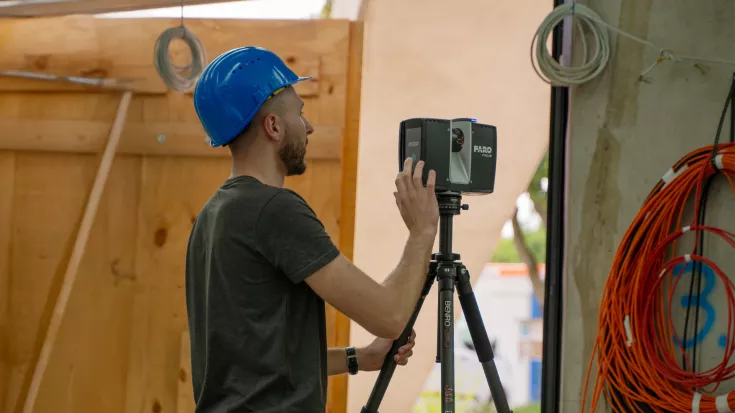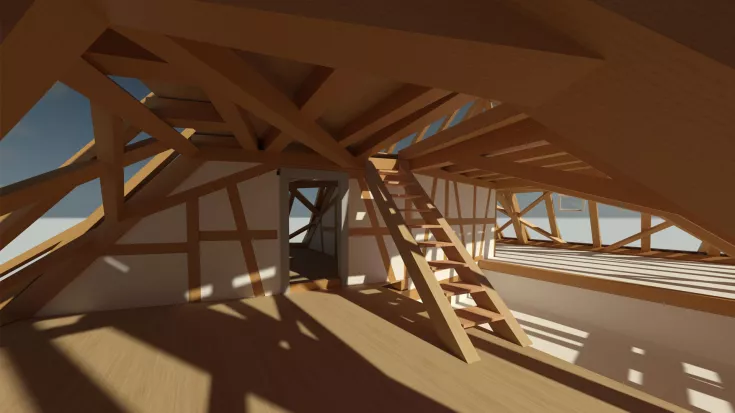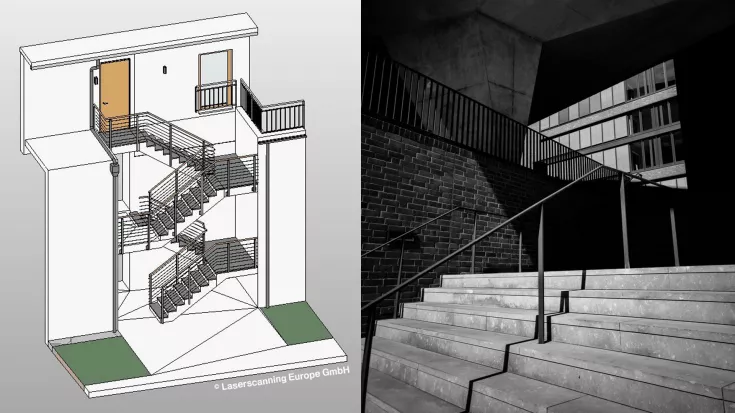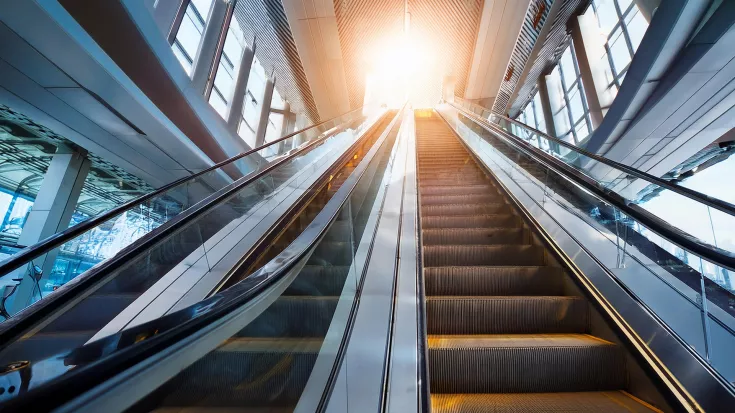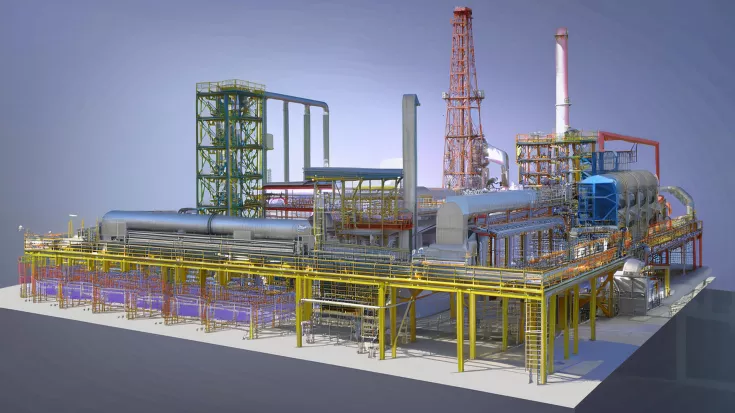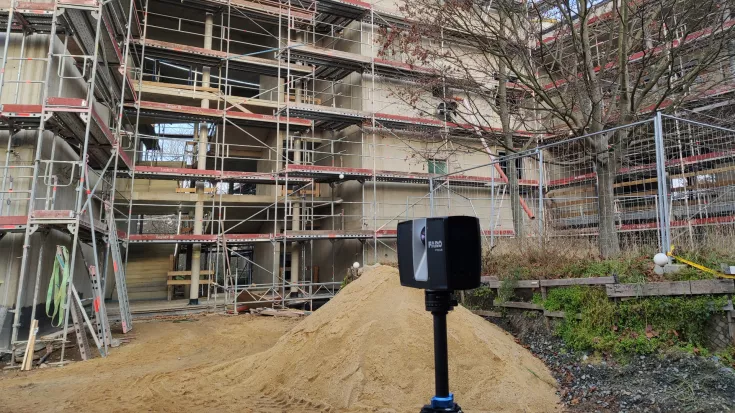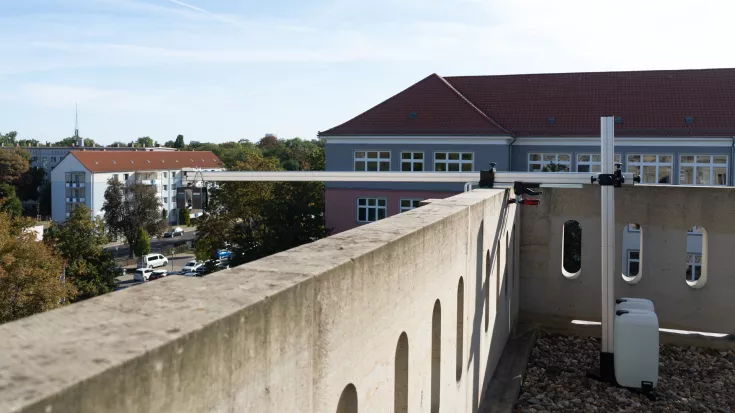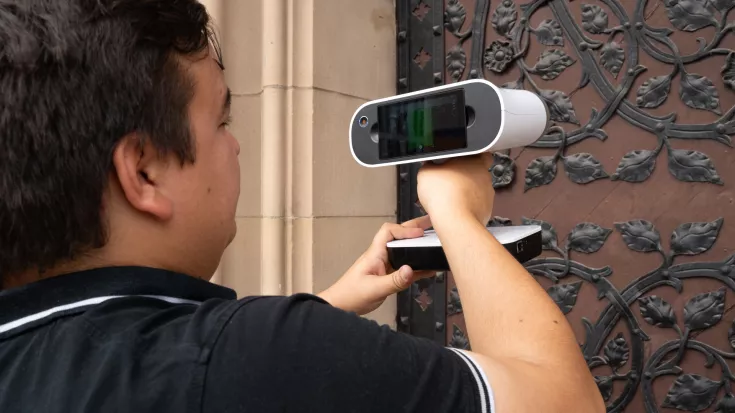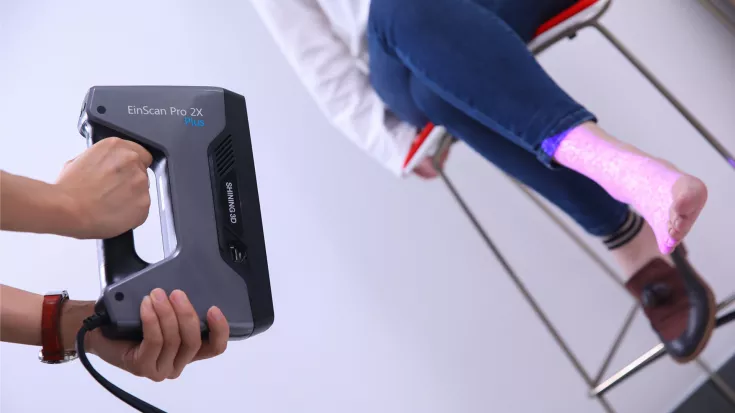Laser Scanning & 3D Modeling in Crafts
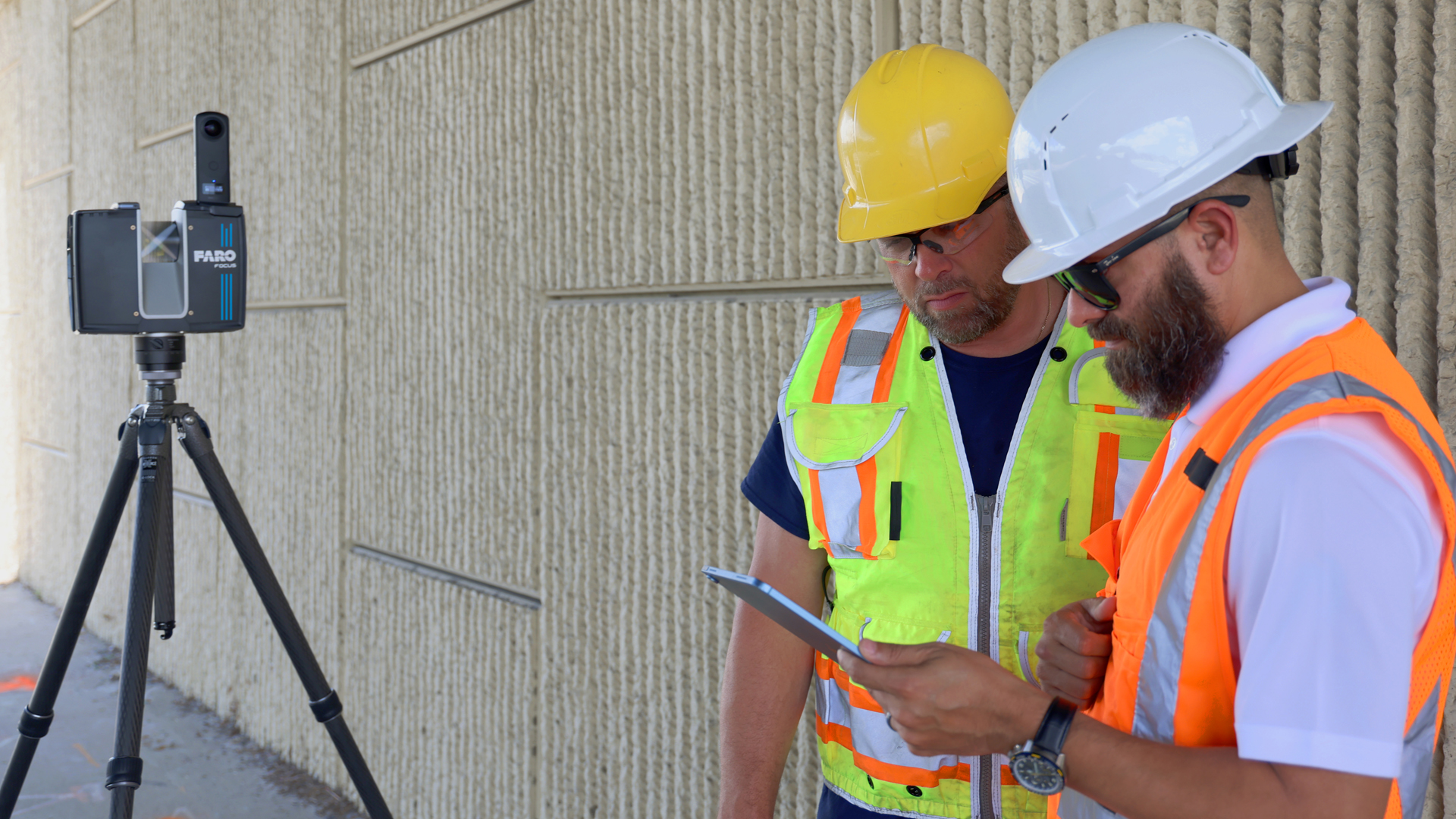
TitleLaser scanning in crafts: Precision meets innovation
Laser scanning is revolutionizing the trade, especially in surveying, which plays a central role in the construction industry. As a modern method of building surveying, laser scanning enables high-precision recording and documentation of existing buildings and structures.
The resulting construction drawings provide a sound basis for planning, minimize errors and are essential for determining the exact scope of work. Laser scanning not only facilitates the preparation of tenders, but also the inspection of work carried out - and thus raises measurement in the skilled trades to a new, digital level.
TitleDigital measurement on the construction site
In the past and today, folding rules, measuring tapes and measuring wheels are still frequently used. Later, digital measurement was developed. This naturally includes the Disto as a laser rangefinder. The Flexijet, for example, was then developed on the basis of the Disto. Alternatively, total stations are also used on construction sites. The Disto was used very quickly in many areas, while more complex laser systems were only used in special areas.
Traditional surveying methods, which are often time-consuming and error-prone, are increasingly giving way to modern technologies.
TitleWhen are laser scanners used in craft trades?
The use of laser scanning makes it possible to capture exact 3D data, which provides you as a trade professional with a precise basis for planning and implementing your projects.
The first laser scanners became available to the general public in the mid-2000s. However, the prices were still very high. Only a few special applications in the field of restoration were already being carried out with laser scanners. Devices from universities were mostly used here.
It was not until around 2013 that the first low-cost laser scanner, the FARO scanner, came onto the market. In addition to industry and engineering, the first applications started in the crafts industry.
Laser scanners primarily compete with point-based measuring systems such as the Flexijet. If the building objects have complex spatial or partially deformed geometry or the areas are very large or difficult to access, the laser scanner is often the better choice. If only a few precisely defined points are required for the construction project, a point measurement system is often the better choice.
TitleAdvantages & benefits of laser scanning in crafts
Time & cost savings
The fast and precise capture of 3D data significantly reduces planning and surveying times. This not only reduces the amount of work involved, but also minimizes expensive rework, which often occurs with traditional measuring methods.
Increased accuracy
The generated point clouds provide exact dimensions and details that enable precise planning and implementation. The result is customized solutions that are perfectly tailored to the respective project – from renovations to complete new builds.
Optimization of work processes
Digital data enables seamless integration into CAD programs and other planning software. This facilitates collaboration between tradespeople, architects and engineers, as everyone involved works on a shared database. In addition, digital models can be easily archived and reused for future projects.
Quality assurance & reduction of errors
The precise capture of all relevant dimensions and geometries significantly reduces planning errors. This leads to a higher quality of the work carried out and a lasting improvement in customer satisfaction.
Title3D scanners in crafts - This is the workflow!
The topic of laser scanning in the trade is becoming increasingly popular. Many tradespeople are now doing away with tedious measurements using folding rulers and tape measures and are instead using modern technologies such as laser scanners. The scanner captures several million points per second with an accuracy in the millimeter range.
In the video, Henrik Derksen (carpenter, founder of ARTline) talks about the role of 3D scanners in his day-to-day work. He explains the complete workflow for scanning in the trade, the analysis of the scan results and what to look out for.
TitleIn which trades are laser scanners used?
Laser scanners are used in a wide range of applications in the trades, for example in
- Carpentry and timber construction, interior fittings and furnishings
- Store and hotel furnishings
- Staircase construction
- Elevator construction
- Steel and facade construction
- Scaffolding
- Restoration
- Orthopaedic technology
TitleLaser scanner for carpentry & timber construction
Laser scanners offer carpentry and timber construction companies a precise and efficient solution for measuring complex structures. With laser technology, rooms, walls and individual components can be captured with millimeter precision, making the planning and production of precisely fitting wooden elements much easier.
Whether for custom-made furniture, fixtures or complex wooden structures – laser scanners enable precise advance planning and reduce errors during implementation, saving time and material costs.
TitleSurvey & roof truss renovation with the 3D scanner
In this video, we show how we supported the Sünderhauf carpentry firm in the renovation of a three-sided courtyard.
With the help of the FARO Focus laser scanner, a precise point cloud was created as the basis for the as-built model.
Following individual training, the carpentry firm now uses its own laser scanners and the Sema CAD software to design the new roof truss directly from the point cloud. Experience how modern technology is revolutionizing construction projects!
TitleLaser scanners in interior design & furniture construction
In interior design, furnishing, store fitting and hotel interior design, laser scanners make it much easier to plan and implement customized concepts. They enable rooms to be captured in great detail, allowing individual furniture and furnishings to be precisely adapted. Thanks to the exact measurements, even complex room structures and difficult angles can be digitally captured quickly and without errors.
This speeds up the entire planning process, minimizes on-site adjustments and ensures precisely fitting, high-quality results - ideal for sophisticated store and hotel interiors that combine design and functionality.
TitleLaser scanners in staircase construction
In staircase construction, laser scanners offer a precise and efficient way of creating complex measurements directly on site. With their help, all relevant dimensions, angles and height differences can be recorded with millimeter precision, which enables exact planning and production of precisely fitting staircase elements.
Digital recording not only speeds up planning, but also minimizes the error rate, as all data can be transferred directly to CAD software. The use of laser scanners in staircase construction therefore saves time and money and ensures a perfect fit and high quality.
TitleLaser scanner in elevator construction & escalator construction
In modern elevator construction, the use of laser scanners for the precise measurement of existing elevator shafts and escalators has become indispensable. Laser scanners enable highly accurate, three-dimensional measurement, which is crucial for both the planning of new buildings and the modernization of existing installations.
By capturing detailed point clouds, the spatial conditions of a shaft or escalator area can be mapped completely and with millimeter precision. This considerably simplifies the planning of customized elevator or escalator solutions and reduces the likelihood of expensive adjustments during the construction phase. Particularly in older buildings with imprecise construction plans, the laser scanner provides reliable data that ensures safe and efficient project implementation.
This technology also helps to increase safety and shorten installation times, as all relevant dimensions can be precisely captured in advance and processed in the digital model.
TitleLaser scanners in steel construction
Laser scanners have become an integral part of steel construction, enabling existing steel structures and existing buildings to be measured precisely and efficiently. The technology makes it possible to depict complex structures as detailed 3D models in the shortest possible time. The precise measurement allows all structures and connections to be recorded, which is particularly advantageous for renovations or extensions.
The captured data can be integrated into BIM (Building Information Modeling) models, which considerably simplifies the planning and coordination of construction projects and minimizes risks due to planning errors.
TitleLaser scanners in scaffolding construction: Precise measurement for optimum safety
In scaffolding construction, the use of laser scanners ensures precise measurement of the building's surroundings and thus facilitates the planning of customized scaffolding constructions. The laser scanners capture the building with millimeter precision and generate a 3D model that serves as the basis for scaffolding planning.
All relevant details such as overhangs, projections and irregular façades can be precisely recorded, particularly in the case of complex building structures or listed buildings. This increases safety and efficiency during scaffolding assembly, as adjustments on site are minimized and planning errors are reduced.
TitleLaser scanners in façade construction
In façade construction, precise measurements are essential in order to optimally match façade elements to the building structure. Laser scanners provide a complete 3D model of the existing façade and capture even the finest details and unevenness.
This enables precise planning and production of the façade elements, which means that on-site installation can be carried out efficiently and without major adjustments. The accuracy of laser scanning technology thus helps to reduce sources of error and optimize construction time - important factors for successful façade projects.
TitleLaser scanners in restoration: Preservation of existing buildings & cultural assets
Laser scanners are also used in restoration work to document the exact condition of existing buildings and cultural and historical assets down to the last detail. The technology enables non-contact measurement that captures even the finest structures, surfaces and details with millimeter precision and depicts them as a complete 3D model. This is particularly valuable for the restoration of sensitive or inaccessible components and works of art, as potential contact is avoided and all dimensions are precisely recorded.
Thanks to the data obtained, restorers and planners can implement measures in a targeted and material-saving manner without unnecessarily damaging the historical substance. Laser scanning thus ensures the long-term preservation and faithful restoration of valuable buildings and cultural assets.
TitleLaser scanners in orthopaedic technology
In orthopaedic technology, laser scanners enable high-precision, non-contact measurement of bodies and body parts. This technology provides the ideal basis for the precise manufacture of orthopaedic aids such as prostheses, orthoses or shoe inserts. Thanks to the detailed 3D model, even the finest anatomical features can be captured and integrated into the design of the medical aids, ensuring maximum comfort and functionality.
The use of laser scanners saves time and avoids inconvenience, as conventional plaster casts or adjustments often become superfluous. The result is customized solutions that improve patients' mobility and quality of life and are tailored precisely to their individual needs.

